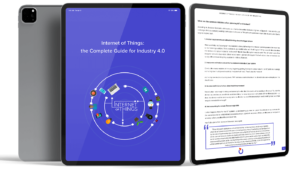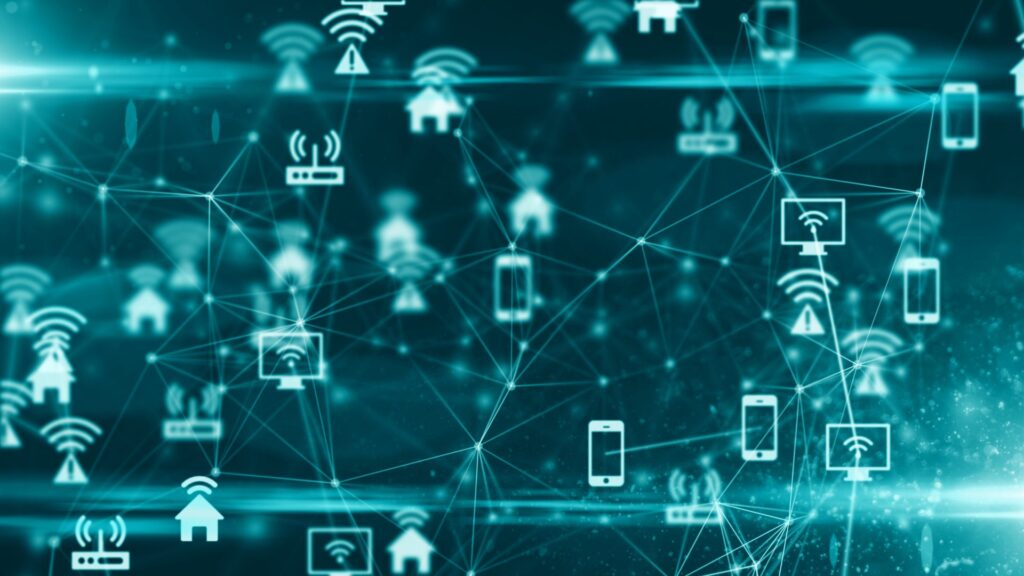IoT connectivity options – how to choose the right one?
Internet of Things (IoT) connectivity refers to the methods of connecting IoT devices between themselves and the Internet or local networks, allowing them to communicate with each other or with applications and services hosted on servers or the cloud. The market of connectivity options is vast and constantly evolving. A plethora of connectivity technologies are suitable for specific needs, varying from short-range ones based on RFID to broadband Internet.
Learn more about IoT in Industry 4.0 from our guide
Download the ebookCertain connectivity technologies are characteristic for IoT, for example, the RFID mentioned above, Bluetooth, Wi-Fi, or the whole variety of mobile connectivity options – from LTE to good old 2G, GSM and GPRS.
In this article, created in cooperation with Krzysztof Maciejewski, our Lead Embedded Architect and expert in connectivity, we’re discussing various IoT connectivity options with a focus on how to match them to your needs and requirements.
What are the connectivity options, and how do they compare?
Let’s now analyse some of these technologies in terms of range, bandwidth, latency, power consumption and cost. These factors are pivotal for making the right decision for the IoT connectivity solution. For example, certain technologies with very small bandwidth consume little power because they run on a battery expected to last for their whole lifecycle. However, due to the small bandwidth, they can have two-week latency in data transfer. Thus, it’s crucial to match the technology to your needs and expectations.
Below, you can read more about the criteria that you should take into consideration when choosing the right connectivity option for your IoT solution:
Range
There are close-range technologies, such as RFID, NFC, Bluetooth, or Wi-Fi, whose range is measured in feet. A connectivity option with a larger range is a mobile network, particularly cellular networks, which provide wide-area coverage and are essential for remote devices. Its range depends on how developed it is, but usually, it’s a matter of miles. There are also satellite connectivity options with a global range. In this case, though, a large range entails higher costs.
Costs
We already mentioned that satellite connectivity is probably the most costly option. The choice of network operator can significantly influence deployment expenses and ongoing connectivity costs. Mobile network connectivity largely depends on the amount of data transferred – it can be relatively cheap or pretty expensive. Bluetooth, if used for local network connection and/or without internet access doesn’t generate any costs other than the costs of power consumption. If Bluetooth is used to access the Internet through a certain gateway, then you must also include the cost of data transfer through such a gateway.
As you can see, the cost of IoT connectivity greatly depends on the range and size of the data transfer.
Data throughput bandwidth
Bandwidth is closely tied to the range and cost. The more data you want to transfer, the higher the cost and the more difficult it is at close range. Data speed is crucial for high-bandwidth needs, such as streaming video and real-time data transmission.
For wireless IoT connectivity options, the larger the distance, the slower the data transfer speed. In the case of wired connectivity options, like ethernet or fibre, the bandwidth is significantly bigger than for wireless solutions. However, the cost gets higher as you have to establish the whole infrastructure, get the cables, establish the connection and pay the vendor.
Power consumption
Some technologies for connected devices, such as a mobile network, are quite electricity-consuming. This may be a problem when a device transmits a lot of data while working on a battery.
However, there are certain technologies that enable using one battery for the whole life cycle of a device. In such a case, of course, the power consumption must be minimal. It can be achieved by limiting data transfer and range, which results in significantly lower power consumption but greater latency.
Certain mobile network technologies introduced special sub-standards, like LTE Narrowband IoT. It allows transmitting data at low speed, keeping power consumption at a minimum, so a device may indeed run on one battery throughout its whole life cycle.
The choice of IoT connectivity method should be driven by our needs in the first place. If you want to track vehicles in real time, then an inexpensive yet high-latency technology won’t meet your requirements. In such a case, you have to take into account that a lower-latency technology entails significantly higher cost and power consumption.
Wired vs wireless IoT connectivity options
Wired technologies used for IoT connectivity are LAN, ethernet and rarely a dial-up telephone network. Contrary to many beliefs, the latter may be a good solution due to its reliability, despite an average data transfer speed. There’s also fibre optic Internet. If high bandwidth is essential for your IoT solution (for example, it’s used to send pictures in real-time), then this would probably be your option of choice. Different network technologies manage data packets effectively based on the bandwidth and specific use cases of IoT devices.
When it comes to wireless IoT connectivity options, there are low-power-consumption ones, like the LTE Cat M mentioned above and Narrowband IoT, as well as Wi-Fi and Bluetooth. There’s also meshnet – a wireless network organised in a mesh typology, which doesn’t have a central point where devices can communicate directly with each other. It’s quite commonly used in smart homes.
A more extreme example of a wireless IoT connectivity option is satellite connectivity. It enables access to the Internet even from the middle of a desert. Another instance of a less common wireless IoT connectivity technology is LP WAN (Low Power Wide Area Network). As the name suggests, it needs very little power to operate and has a range of tens of miles. It has one central connectivity point, but the IoT devices (usually various farming machines) are scattered on a large, non urbanised area.
Despite all the odds, GSM or GPRS (2G) technology introduced in the 90s is still in use and in quite a good shape. Organisations decide on 2G usually in cases when their IoT solution doesn’t require much data transfer. It’s still a stable and reliable connectivity option with a pretty wide range compared to other technologies.
The automotive industry sees the development of V2X (vehicle to everything) solutions, enabling vehicles to communicate with each other or the infrastructure. The IoT connectivity technologies used for this solution are usually Wi-Fi or certain mobile network standards.
Learn more about IoT in Industry 4.0 from our guide
Download the ebookWhat’s the future of IoT connectivity?
Connectivity technologies are constantly evolving, but it’s hard to clearly determine the direction in which the development of connectivity technologies will turn. The main trend is not yet distinguished, however, there are two main players: Wi-Fi and mobile network. Currently, work is underway on another version of the Wi-Fi standard, which will be better adjusted for the more and more popular IoT solutions. The focus is on improving the power consumption and range.
For example, in the case of V2X solutions, Wi-Fi is a leading wireless connectivity option in the USA. Yet, another global superpower, China, leans more towards the mobile network. In Europe, both options are popular, which, to be honest, isn’t the best scenario due to possible compatibility issues.
5G is not yet a first-choice technology in Europe due to higher costs in comparison to other options. In terms of cost optimisation, the leaders are LTE Cat M, Narrowband IoT, Wi-Fi or even 2G. Even 1 dollar savings per device makes a huge difference on a large scale.
About the author
Embark on your digital automation journey with us. Reach out to our experts to discuss your needs.
RECOMMENDED ARTICLES





